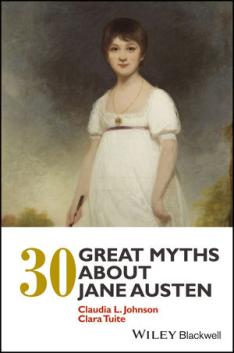
The book: 30 Great Myths about Jane Austen (Wiley) studies the life and reception of Jane Austen, including questions about her personal characteristics, how her works were intended or received, and her enduring legacy. Each chapter can be read on its own, making this work an approachable study on Jane Austen for readers interested in knowing more about the prolific and widely loved author.
Instead of merely dismissing or validating myths about Austen’s life and work, Claudia L. Johnson *81 and Clara Tuite take an analytical approach. Myths about Austen are explored as a tool for further understanding the impact of her greatest novels and lesser-known works as well as her contributions to the burgeoning field of literary criticism.
The authors: Claudia L. Johnson *81 is the Murray Professor of English at Princeton University. She specializes in 18th-century and 19th-century British literature, and gender studies. Renowned for her works on Jane Austen and Mary Wollstonecraft, Johnson’s books include Jane Austen: Women, Politics, and the Novel; Equivocal Beings: Politics, Gender and Sentimentality in the 1790s; and Jane Austen’s Cults and Cultures, which won the Christian Gauss Award.Clara Tuite is Professor of English at the University of Melbourne, a co-director of the Enlightenment, Romanticism and Contemporary Culture Research Unit, and a Fellow of the Australian Academy of the Humanities. Her books include Romantic Austen: Sexual Politics and the Literary Canon and Lord Byron and Scandalous Celebrity, which was awarded the Elma Dangerfield Prize by the International Association of Byron Societies.
Opening lines: Myth 1: Austen had no interest in fame
This myth was hatched by Jane Austen’s brother, Henry Austen, in the “Biographical Notice of the Author” that appeared with Northanger Abbey and Persuasion when they were posthumously published in 1818: “Neither the hope of fame nor profit mixed with her early motives.” According to this myth, Austen took up novel‐writing in secret, merely as a leisure pursuit; she had no intention of publishing, but her brothers found the manuscripts and brought them to life as published works, with little involvement or investment from Austen herself.
The trouble with this account of Austen’s “motives” is that it assumes she was not interested in being a professional writer. But this is problematic. To be sure, Jane Austen’s name did not appear on the title‐pages of any of the lifetime editions of her novels; and it was not until Henry’s obituary notice appeared that Austen’s novels were attributed to her in print. But her letters make it clear that being a published author – not just a writer – was important to her.
How and why did the myth come about? The mythmaking can be understood partly as the Austen family’s attempt to deal with the increasing public interest in Austen and her writing that developed after her death. Cultured but religiously orthodox and occupying the fringes of the gentry, the family managed Austen’s growing reputation by ensuring she would be remembered as a model of modest and devout femininity. According to the traditional view, “proper” women did not put themselves out in public for money, and the elite were traditionally ambivalent about writing for money as a form of lowering oneself to “trade.”
This is not to deny that large numbers of women took up writing for money in this period. They did. But when they did so, they had to contend with traditional understandings of proper femininity as incompatible with publicity and therefore of fame almost as a form of social impropriety. Despite these social obstacles, the early nineteenth century witnessed an explosion of women’s writing. Austen was among a vast number of women at this time who were challenging these traditional understandings by publishing their writing. But her family was ambivalent.
We should also consider the motivations of Henry Austen himself. Having been declared bankrupt in 1816, he probably sought some measure of recognition as the enterprising agent who conducted his sister’s business dealings. So, paradoxically, his declaration of modesty on Jane’s part was a likely claim for vindication, vying for attention himself. Although Henry portrayed himself as Austen’s enterprising agent, who was assumed to have done most of the negotiations on her behalf, Austen met with her first publisher, Thomas Egerton, about a second edition of Mansfield Park; and in her later negotiations with James Stanier Clarke and John Murray, she acted as an increasingly confident literary professional.
In addition to these familial considerations, fame itself must be understood as a complex and changing social form. Jane Austen was writing at a time when fame was undergoing immense change as a result of the emergence of celebrity culture. The market necessitated new strategies for managing fame recognition and the enhanced aura of the author, who had become a newly intriguing and spectacular figure. During the Romantic period, the literary institution transitioned from a patronage system (where authors were known to their readers) into a fully fledged market system (where authors’ work was produced for an anonymous public). Paradoxically, the Romantic myth of the author as an inspired creator oblivious of financial interest coincided with the very moment when the author emerged both as the producer of a commodity and as a commodity herself.
The emergence of the institution of literary property and the Romantic conception of authorship entailed new strategies of immortality, and new ways of managing fame. The practice of anonymity was one of these. Austen’s first published novel, Sense and Sensibility (1811), was signed with that mystical pseudonym of female authorship – “BY A LADY” – which is also a declaration of anonymity. This paradox — where the signature that blazons anonymity also confers authorship – suggests that the authorial anonymity can be regarded as an initiation into public authorship as well as a retreat from it. Accordingly, fame, anonymity, publicity, and secrecy can be viewed as different points along a continuum, thereby complicating and nuancing an absolute distinction between fame and anonymity …
Where is Austen located among these changing forms of fame? She relied on a range of measures to conceal her identity as an author, preferring it to be known only within her family. But she was proud of her developing oeuvre and took steps to link her novels to one another. Kathryn Sutherland notes that “each new novel invok[es] the assistance of its predecessors. Such assistance is strictly inconsistent with absolute anonymity; on the contrary, her title‐pages map a knowable fictional space or estate: ‘MANSFIELD PARK: A NOVEL. … BY THE AUTHOR OF ‘SENSE AND SENSIBILITY,’ AND ‘PRIDE AND PREJUDICE.’ ”
For Gérard Genette, the phrase “by a lady” is “a statement of identity precisely between two anonymities, explicitly putting at the service of a new book the success of a previous one and, above all, managing to constitute an authorial entity without having recourse to any name, authentic or fictive.” Austen’s wish to maintain a degree of anonymity, and the fact that “in public she turned away from any allusion to the character of an authoress,” does not make her any less professional about her writing or any less interested in seeking an appreciative audience for it. Rather, it was simply that the particular “character of an authoress” Austen chose was that of the anonymous authoress.
Austen’s desire to be a published writer — to take that extra step and turn her writing into a book to be sold and read — is evident in the efforts she took to be published and in her frustration over failed attempts. A striking example of both occurs in her “Advertisement, By the Authoress” to Northanger Abbey, which informs the reader about the circumstances of the novel’s delayed publication, expressing a distinct irritation… Unloading her incredulity in this withering critique of the “bookseller” (Crosby & Co.) who purchased the original manuscript, Austen’s appeal to the reader also functions — intriguingly — to mediate her transition from obscurity to fame.
Northanger Abbey was Austen’s earliest drafted novel, yet by the time Austen wrote this preface and the novel made its belated entrance into the public domain, “the author” had already achieved no small measure of fame with three well‐regarded novels, hence Austen’s anxiousness over the delay which threatened the novel with instant obsolescence. That Austen would not live to see her first‐written novel in print, and that it would appear posthumously with her last‐completed novel (Persuasion), adds a further layer of irony to her eloquent outrage. In another untimely twist, the voice of the author so irked by the prospect of the novel’s coming too late, and being changed beyond recognition from its “period,” arrives as the voice of the author beyond the grave (all too soon). Prefacing the two novels in the first edition of the book itself is the “Biographical Notice of the Author” written by Henry — the text that publicly identifies “Jane Austen” as the author of her novels for the very first time.

